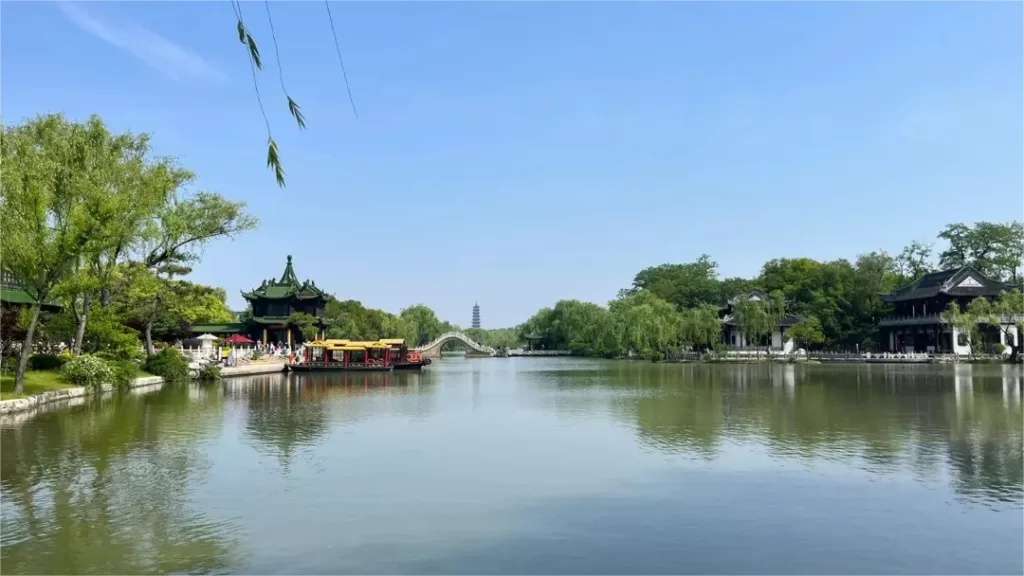The Minor Qinhuai River (小秦淮河), located in the ancient city of Yangzhou in Jiangsu Province, is a charming inner-city waterway that has retained its historical and cultural significance. Formerly known as the New City River, it got the name “Minor Qinhuai” during the Kangxi era in Qing Dynasty, inspired by the architectural resemblance of its surroundings to the iconic Qinhuai River in Nanjing.
This river has borne witness to the rise and fall of Yangzhou during the Ming and Qing dynasties. In its heyday, the Minor Qinhuai River and its adjacent neighborhoods were bustling hubs of activity.
The beauty of the Minor Qinhuai River is not limited to its picturesque natural scenery. It also features meticulously designed railings, a series of ancient arched bridges that span its width, and the delightful greenery that adorns its banks. The quaint architecture on both sides of the river, old-fashioned residential houses, and the languid pace of life it represents all contribute to its unique charm.
Table of Contents
- Basic Information
- Location and Transportation
- Highlights of Minor Qinhuai River
- Attractions near Minor Qinhuai River
Basic Information
| Estimated Length of Tour | 0.5 – 1 hour |
| Ticket Price | Free |
| Opening Hours | 24 hours a day |
Location and Transportation
The Minor Qinhuai River stretches for approximately 2 kilometers, flowing from the northern connection with the North City River to the southern exit at Longtou Pass, where it joins the Grand Canal. To get there, tourists can take bus 1, 6, 19, 40, 66, 68, or 126, get off at Yucai Primary Stop (育才小学站), and walk about 200 meters to the east.
Highlights of Minor Qinhuai River
Traditional Courtyards

The Minor Qinhuai River is adorned with over ten brick and stone single-arch bridges that gracefully cross its waters. In the past, there were boat rides through these bridges that would take visitors directly to the famous Slender West Lake. The residents along the riverbanks typically dwell in single courtyards with pink walls, dark-tiled roofs, and horse-head walls. The entire 2-kilometer stretch of the river is lined with stone railings and framed by peach and willow trees, creating a picturesque scene that makes strolling along the river feel like walking in a painting.
Willow Trees and Peach Blossoms

As you move further south from the Dadaomen Bridge, you’ll be greeted by the sight of willow trees and peach blossoms reflecting in the water. The variety of peach tree blooms includes both double and single petals, coming in shades of pale white, pink, bright red, and multicolored. During the peak of spring in March, the banks of the Minor Qinhuai River are filled with a riot of colorful flowers, accompanied by the buzzing of bees collecting nectar. In the rainy season, fine and gentle raindrops make the foliage even more lush and vibrant. The fragrance of white osmanthus flowers wafts from the green window sills of riverside homes, creating a constant, intoxicating aroma that seems to permeate the dreams of the fortunate residents.
Secluded Theater

Moving south from the Xidongmen Bridge, the Minor Qinhuai River gradually becomes more secluded. Towering paulownia trees stand lonely along the riverbanks, their purple blossoms illuminated by the fading sunlight of late spring evenings. Not far from there is the Ruyi Bridge, which marks the former site of the “Grand Stage.” In 1911, the Grand Stage was built beside the Minor Qinhuai River, serving as a theater with over 1,300 seats and as the cultural and entertainment center for the people of Yangzhou. However, it was closed in 1964. Today, the Grand Stage stands like an aging elder by the side of the Minor Qinhuai River, with its stage now eerily quiet.







